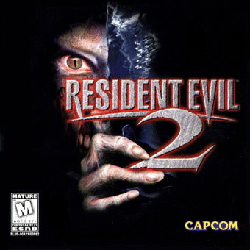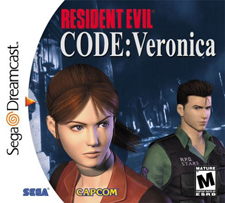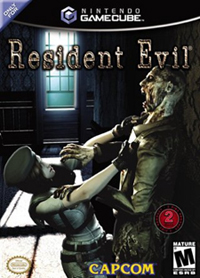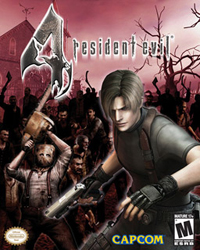Powet Alphabet: R is for Resident Evil (games)
by Sindra, filed in Games, Powet Alphabet on May.01, 2010
 Since the alphabet is the building block of our language, the Powet Alphabet is the building block of what makes us geeks.
Since the alphabet is the building block of our language, the Powet Alphabet is the building block of what makes us geeks.
Zombies – they’re a staple of film and games alike. Pioneered by the likes of George Romero’s “Night of the Living Dead” and its sequels, and followed by the slightly less-serious “Return of the Living Dead” movies and scores of others in the horror genre, zombies have been a tool of the entertainment industry for decades. Games began using them as early as the late 80’s, with Castlevania starting the trend of pixelizing the undead, and the idea taking off with subsequent games such as DOOM and the less-than-terrifying “Zombies Ate my Neighbors”. The idea of the dead coming back to life in order to devour the living has been used to great effect in all types of media, and tend to do rather well because of a good chunk of the populace having a morbid fascination with not only the undead, but more importantly – killing the undead. Capcom decided that, by the mid-1990’s with video games starting to become mainstreamed in the media, that it would try its hand at capitalizing on the concept.
Enter Resident Evil (Biohazard) in 1996 for the Playstation. (the name “Biohazard” had to be changed in North America due to trademark issues) Created by Shinji Mikami, the story of the game borrows heavily from the Romero movies. Mikami sought to capture the same feeling of intense raw emotional appeal and feel of the NotLD movie with a feeling of being trapped close-quarters with inexplicable undead roaming all around you, and spur the survival aspect of what would go on to be one of the staples of the survival-horror genre of video games. The story of the game also at least partially-mimics the feel of the Romero movies. The fictional Raccoon City in the midwest is a bustling mini-metropolis thanks to the global pharmaceutical giant known as the Umbrella Corporation. The only problem this seemingly pleasant and orderly city has is that mutilates corpses have started to pop up on the outskirts of town. As the number of fatal attacks rise, many which feature the victims partially-eaten, the chief of the Raccoon City police decides to send in their elite S.T.A.R.S. unit to investigate. However, after Bravo Team disappears, it’s up to the Alpha Team to figure out what’s going on. However, this leads them into a nightmare that extends beyond anything they had ever imagined.
pleasant and orderly city has is that mutilates corpses have started to pop up on the outskirts of town. As the number of fatal attacks rise, many which feature the victims partially-eaten, the chief of the Raccoon City police decides to send in their elite S.T.A.R.S. unit to investigate. However, after Bravo Team disappears, it’s up to the Alpha Team to figure out what’s going on. However, this leads them into a nightmare that extends beyond anything they had ever imagined.
 The first game became a cult-classic, despite having rather poor graphics and shaky controls and 3rd-person camera. It sold enough copies in Japan and America to warrant the green-light for 2 sequels. Resident Evil 2 came out in 1998 for the Playstation with a port on the N64. The game detailed an expansion of the story from the first game. The plague that created the zombies from the first game has been released beneath Raccoon City itself, creating a wide-scale zombie outbreak. The city has gone to hell with few survivors, and a team consisting of a rookie cop and the sister of the first game’s protagonist are two of the few people left living to fend off the undead hordes and make it out of the city alive. Resident Evil 2 faired better than its predecessor with slightly improved graphics and controls and an expanded repertoire of weapons and grotesque creatures. Resident Evil 3 came out not even a year later and faired decently, but couldn’t reach the same sales or status that RE2 had garnered, bringing even more to the genre of survival horror and creating an ample fanbase. RE3 also brought back one of the first game’s protagonists, Jill Valentine.
The first game became a cult-classic, despite having rather poor graphics and shaky controls and 3rd-person camera. It sold enough copies in Japan and America to warrant the green-light for 2 sequels. Resident Evil 2 came out in 1998 for the Playstation with a port on the N64. The game detailed an expansion of the story from the first game. The plague that created the zombies from the first game has been released beneath Raccoon City itself, creating a wide-scale zombie outbreak. The city has gone to hell with few survivors, and a team consisting of a rookie cop and the sister of the first game’s protagonist are two of the few people left living to fend off the undead hordes and make it out of the city alive. Resident Evil 2 faired better than its predecessor with slightly improved graphics and controls and an expanded repertoire of weapons and grotesque creatures. Resident Evil 3 came out not even a year later and faired decently, but couldn’t reach the same sales or status that RE2 had garnered, bringing even more to the genre of survival horror and creating an ample fanbase. RE3 also brought back one of the first game’s protagonists, Jill Valentine.
 Resident Evil Code: Veronica, the 4th game in the series released in 2000, took pieces of RE2 & RE3 and combined them, along with 3D backgrounds instead of traditional pre-rendered and the addition of continues and duel-wielding weapons. Claire Redfield from the second game returns in her own game, with various other new and returning characters. Released for the Sega Dreamcast as one of the system’s more successful games, Code: Veronica was praised for continuing the series tradition of creepy atmosphere and interesting story coupled with good ol’ fashioned zombie-stomping. The game did well enough to garner an updated re-release titled “Code: Veronica X” with additional cutscenes and small differences in gameplay. It came bundled with the fictional documentary “Wesker’s Report”. (sorry if you were looking not to be spoiled, but Wesker does come back from his “death” in the first game)
Resident Evil Code: Veronica, the 4th game in the series released in 2000, took pieces of RE2 & RE3 and combined them, along with 3D backgrounds instead of traditional pre-rendered and the addition of continues and duel-wielding weapons. Claire Redfield from the second game returns in her own game, with various other new and returning characters. Released for the Sega Dreamcast as one of the system’s more successful games, Code: Veronica was praised for continuing the series tradition of creepy atmosphere and interesting story coupled with good ol’ fashioned zombie-stomping. The game did well enough to garner an updated re-release titled “Code: Veronica X” with additional cutscenes and small differences in gameplay. It came bundled with the fictional documentary “Wesker’s Report”. (sorry if you were looking not to be spoiled, but Wesker does come back from his “death” in the first game)
 After Code: Veronica, the Resident Evil series decided to re-boot itself partially. In 2002, a re-make of the first game was released for the Nintendo Gamecube, which completely updated the visuals into photo-realistic pre-renders, and added new gameplay elements and environments, and included CG cutscenes. It also re-worked the classically awful dialogue of the original game. (no more Jill Sandwich jokes, to the disappointment of some) Shortly after the remake, a prequel game was also released for the Gamecube titled Resident Evil 0, which used the same elements as the remade first game, and expanded on the story and gave minor characters more limelight. It also did away with the fixed item boxes of all the previous games being the only source of item-switching and allowed for items to be dropped altogether.
After Code: Veronica, the Resident Evil series decided to re-boot itself partially. In 2002, a re-make of the first game was released for the Nintendo Gamecube, which completely updated the visuals into photo-realistic pre-renders, and added new gameplay elements and environments, and included CG cutscenes. It also re-worked the classically awful dialogue of the original game. (no more Jill Sandwich jokes, to the disappointment of some) Shortly after the remake, a prequel game was also released for the Gamecube titled Resident Evil 0, which used the same elements as the remade first game, and expanded on the story and gave minor characters more limelight. It also did away with the fixed item boxes of all the previous games being the only source of item-switching and allowed for items to be dropped altogether.
By this time, the series had gained enough popularity to warrant experimentation with side-games and spin-off titles. In 2001, between the releases of Code: Veronica and the RE Remake game, a light-gun game was created and released with the title “Resident Evil: Survivor” for the Playstation, which took a almost completely new story and combined it with a gameplay mechanic not yet used in the series. Though seemingly innovative, however, Survivor didn’t fair well with critics, gaining poor reviews. Regardless, a “Survivor 2” was created and released as a side-story to the Code:Veronica game. (and when I say side-story, I mean “dream sequence”…..I didn’t say it was good)
It faired even worse than its predecessor and it generally ignored by the fanbase. The best of the “Survivor” series came with the 3rd installment titled “Resident Evil: Dead Aim” in 2003, which managed to combine the light-gun mechanic and switches from 3rd-person to 1st-person views, rather than being strictly 3rd-person like the first two games. This, combined with an interesting-enough story, gained it a more favorable critique.
 By this time, the main series had been on hiatus for quite some time, with another new game nary in-sight in a few years. This was due to the supposed “Resident Evil 4” game being scrapped halfway through production and being almost completely re-done, which gained much outcry from impatient fans. In 2005, over 3 years after a main-series game was released, the true RE4 game was finally brought out as one of the last releases for the Gamecube, and proved to be well-worth the wait. The entire structure of gameplay had been re-tooled, including interactive environments, over-the-shoulder camera angles, a huge focus on crowd-control and large-numbered enemy groupings, and area-specific targeting. It was also one of the first games to feature quick-time events, requiring the player to make split-second reactions to button-prompts in order to avoid catastrophic encounters. The other huge difference in Resident Evil 4 beyond the difference in gameplay was its stark departure from being strictly survival-horror, and being much more action-oriented. Gone were the virally-infected zombies that were the series mainstay, which were replaced by zombie-esque enemies who were much more humanized and intelligent, which effected the old “shoot ‘em til they fall” strategy that, for the most part, worked well in previous games. Now enemies could dodge and call for help, requiring quicker responses from the player and more complex strategy. Many fans praised this as being just the kind of shake-up the series needed to keep it from going stale, while others condemned it for straying too far from the atmosphere that made the other RE games so great, especially the lack of zombies. Either way, Resident Evil 4 gained high sales and higher scores from critics, and even a little fan-service for the few female fans with the return of bishonen Leon Kennedy, not seen since RE2.
By this time, the main series had been on hiatus for quite some time, with another new game nary in-sight in a few years. This was due to the supposed “Resident Evil 4” game being scrapped halfway through production and being almost completely re-done, which gained much outcry from impatient fans. In 2005, over 3 years after a main-series game was released, the true RE4 game was finally brought out as one of the last releases for the Gamecube, and proved to be well-worth the wait. The entire structure of gameplay had been re-tooled, including interactive environments, over-the-shoulder camera angles, a huge focus on crowd-control and large-numbered enemy groupings, and area-specific targeting. It was also one of the first games to feature quick-time events, requiring the player to make split-second reactions to button-prompts in order to avoid catastrophic encounters. The other huge difference in Resident Evil 4 beyond the difference in gameplay was its stark departure from being strictly survival-horror, and being much more action-oriented. Gone were the virally-infected zombies that were the series mainstay, which were replaced by zombie-esque enemies who were much more humanized and intelligent, which effected the old “shoot ‘em til they fall” strategy that, for the most part, worked well in previous games. Now enemies could dodge and call for help, requiring quicker responses from the player and more complex strategy. Many fans praised this as being just the kind of shake-up the series needed to keep it from going stale, while others condemned it for straying too far from the atmosphere that made the other RE games so great, especially the lack of zombies. Either way, Resident Evil 4 gained high sales and higher scores from critics, and even a little fan-service for the few female fans with the return of bishonen Leon Kennedy, not seen since RE2.
 The wait for another Resident Evil game from the main series would take another 4 years before being released, which was padded with the rail-shooter “Resident Evil: Umbrella Chronicles” in-between. Resident Evil 5 wouldn’t be released until early 2009 with the return of Chris Redfield from RE1 and Code: Veronica, and while it introduced the concept of having co-op as an option (the second player could be controlled by the AI or another player), it still relied heavily on the same mechanics that made Resident Evil 4 so unique. The game’s graphics were improved over RE4, and the “Mercenaries” minigame of previous games was also included, though critics bashed the control scheme as being shaky and underdeveloped. Fans also criticized the story as straying even further from that of the original games. Regardless, the game’s sales made records in Japan and Europe, and became the highest-selling game of the series to-date. It also featured downloadable content and a “Gold Edition” which added extra scenarios, including a prequel chapter that hearkened back to the days of the original games in terms of feel, including a quick return of zombies, which made many a fan squee.
The wait for another Resident Evil game from the main series would take another 4 years before being released, which was padded with the rail-shooter “Resident Evil: Umbrella Chronicles” in-between. Resident Evil 5 wouldn’t be released until early 2009 with the return of Chris Redfield from RE1 and Code: Veronica, and while it introduced the concept of having co-op as an option (the second player could be controlled by the AI or another player), it still relied heavily on the same mechanics that made Resident Evil 4 so unique. The game’s graphics were improved over RE4, and the “Mercenaries” minigame of previous games was also included, though critics bashed the control scheme as being shaky and underdeveloped. Fans also criticized the story as straying even further from that of the original games. Regardless, the game’s sales made records in Japan and Europe, and became the highest-selling game of the series to-date. It also featured downloadable content and a “Gold Edition” which added extra scenarios, including a prequel chapter that hearkened back to the days of the original games in terms of feel, including a quick return of zombies, which made many a fan squee.
In terms of what the future holds for the Resident Evil games, producer Jun Takeuchi says that Resident Evil 6 will be a “complete reboot” of the series, and could take several years to be released. What this means for the game in the meantime is anyone’s guess. Sister-game to Umbrella Chronicles, titled “Darkside Chronicles” released late last year could indicate that side-stories and re-releases could be the filler to be looked forward to until such a time when the main games continue. Only time will tell.
Wanna Learn More About RE? Check out These Sites:
Project Umbrella
Biohaze
Evil Unleashed


 PS3
PS3
 Famicom Dojo
Famicom Dojo KEEP PLAYING
KEEP PLAYING KEEP PLAYING: Rewind
KEEP PLAYING: Rewind Powet Toys
Powet Toys Powetcast
Powetcast Hitchhiker's Guide POWETcast
Hitchhiker's Guide POWETcast















Pingback: Powet Monthly Digest – May 2010 - POWET.TV: Movies Games Comics and Toys